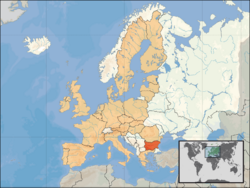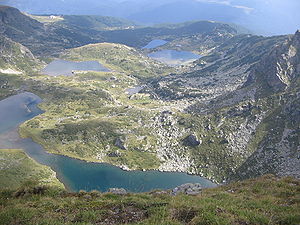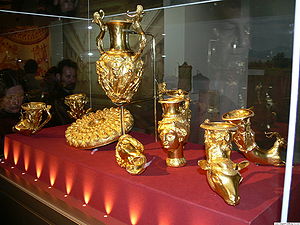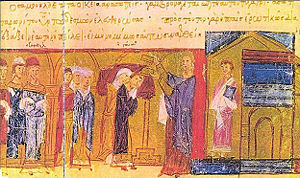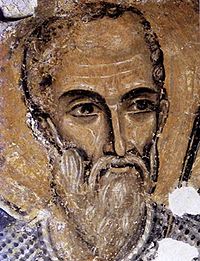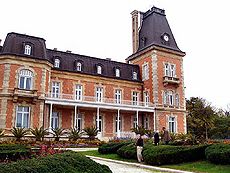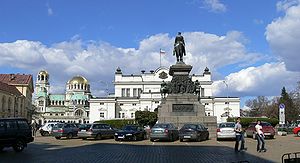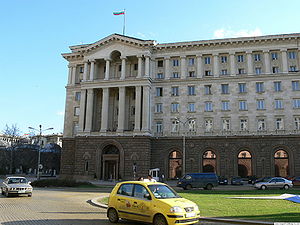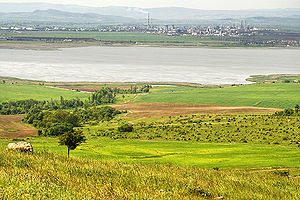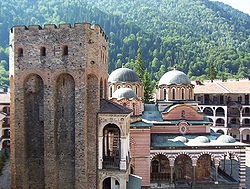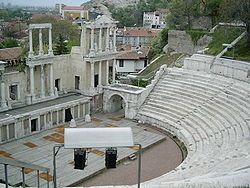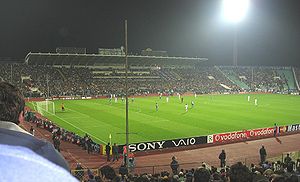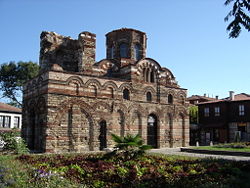Difference between revisions of "Bulgaria" - New World Encyclopedia
Mike Butler (talk | contribs) |
Mike Butler (talk | contribs) m |
||
| Line 228: | Line 228: | ||
==Economy== | ==Economy== | ||
| − | + | [[Image:Sofia-newbuildings-gruev.JPG|right|thumb|300px|Mall of Sofia with the only IMAX cinema in South-Eastern Europe.]] | |
| − | Bulgaria | + | The economy of Bulgaria declined dramatically during the 1990s with the collapse of the COMECON system, which was an economic organization of communist states, and the loss of the [[Soviet]] market, to which the Bulgarian economy had been closely tied. The standard of living fell by about 40 percent, and only regained pre-1989 levels by June of 2004. In addition, United Nations economic sanctions against [[Serbia]] (1992-95) and [[Iraq]] took a heavy toll on the Bulgarian economy. |
| − | + | The first signs of recovery emerged when gross domestic product grew 1.4 percent in 1994 for the first time since 1988, and 2.5 percent in 1995. Inflation, which surged in 1994 to 122 percent, fell to 32.9 percent in 1995. | |
| − | |||
| − | |||
| − | + | During 1996, however, the economy collapsed due to the Bulgarian Socialist Party, slow and mismanaged economic reforms, its disastrous agricultural policy, and an unstable and decentralized banking system, which led to an inflation rate of 311 percent and the collapse of the lev, the Bulgarian currency. When pro-reform forces came into power in the spring 1997, an ambitious economic reform package, including introduction of a currency board regime, was agreed to with the International Monetary Fund and the World Bank, and the economy began to stabilize. As of 2007 the economy is growing at a steady pace of above 5 percent a year with budget deficits and shaky inflation. Future prospects are tied to the country's increasingly important integration with the European Union member states. The country is expected to join the [[Eurozone]] between 2010 and 2012. | |
| − | |||
| − | === | + | ===Agriculture and industry=== |
| − | + | [[Image:Neftochim-vaya-dinev.jpg|left|thumb|300px|Agriculture and industry in Burgas Province — fields near Lake Vaya with the Neftochim Burgas oil refinery on the opposite shore.]] | |
| + | Agricultural output has decreased since 1989, but production is growing in recent years. The prevalence of mechanisation is higher than most other Eastern European countries but there is lack of modern equipment. Alongside aeroplanes and other equipment, there are over 150,000 tractors and 10,000 combine harvesters. The most important crops include wheat, sunflower, maize, grapes, tobacco, tomatoes, barley, potatoes and roses for rose oil. | ||
| − | + | Although Bulgaria is not rich in reserves of coal, oil, and gas, it is a major producer of electricity and the most important exporter in the region due to the Kozloduy Nuclear Power Plant with a total capacity of 3,760 MW. A second plant, the [[Belene Nuclear Power Plant]] with a capacity of 2,000 MW is under construction. There is a $1,400,000,000 project for construction of an additional 670 MW for the 500 MW [[Maritsa Iztok Complex|Maritza Iztok 1]] Thermal Power Plant. | |
| − | The | + | The production of steel and pig iron is concentrated in [[Kremikovtsi]] and [[Pernik]]. There is also a third metallurgical base in [[Debelt]]. The largest refineries for lead and zinc are in Plovdiv, Kardzhali and Novi Iskar; for copper in Pirdop and Eliseina; and for aluminium in Shumen. About 14 percent of the total industrial production is related to machine building and 24 percent of the people are employed in this field. |
| − | + | Electronics and electric equipment production is well developed. The largest centres are [[Sofia]], [[Plovdiv]] and surrounding areas. These plants produce household appliances, computers, CDs, telephones, medical and scientific equipment. | |
| − | + | There are plants producing trains, trams, trolleys, buses, trucks, and motor cars. The main centre of agricultural machinery is [[Ruse]]. Shipbuilding is concentrated in [[Varna]], [[Burgas]] and [[Ruse]]. Arms production is mainly developed in central Bulgaria. | |
| − | + | ===Science and technology=== | |
| − | + | [[Image:Zlatna maska teres.jpg|thumb|150px|right|The Golden mask of a Thracian king.]] | |
| − | |||
| − | |||
| − | == Science | ||
| − | [[Image: | ||
Bulgaria offers excellent conditions for high-tech and telecommunication industries and services with its strategic location, highly-qualified workforce, macroeconomic stability, growing [[domestic market]] and good [[education]]. This is why some multinational companies choose Bulgaria to build their regional offices and headquarters even before Bulgaria joined the EU. The most notable is [[Hewlett-Packard]], which built its Global Service Centre for [[Europe]], the [[Middle East]] and [[Africa]] in Sofia. | Bulgaria offers excellent conditions for high-tech and telecommunication industries and services with its strategic location, highly-qualified workforce, macroeconomic stability, growing [[domestic market]] and good [[education]]. This is why some multinational companies choose Bulgaria to build their regional offices and headquarters even before Bulgaria joined the EU. The most notable is [[Hewlett-Packard]], which built its Global Service Centre for [[Europe]], the [[Middle East]] and [[Africa]] in Sofia. | ||
| − | |||
| − | |||
The country has some precedents for its current science industry. The inventor of the earliest known electronic computer [[John Atanasoff]] is of Bulgarian descent. Bulgaria was a major supplier of scientific and research instruments for the [[Soviet]] space programmes, was the first European country to develop serial computer production, and has experience in pharmaceutical research and development. The [[Bulgarian Academy of Sciences]] is the leading scientific institution in the country with most of the researchers working for its numerous branches. | The country has some precedents for its current science industry. The inventor of the earliest known electronic computer [[John Atanasoff]] is of Bulgarian descent. Bulgaria was a major supplier of scientific and research instruments for the [[Soviet]] space programmes, was the first European country to develop serial computer production, and has experience in pharmaceutical research and development. The [[Bulgarian Academy of Sciences]] is the leading scientific institution in the country with most of the researchers working for its numerous branches. | ||
| − | There are two major | + | There are two major astronomical observatories: the Rozhen Observatory, which is the biggest in South Eastern Europe, and the Belogradchik Observatory, with three telescopes. |
| − | == | + | ===Tourism=== |
| − | [[Image: | + | [[Image:Sunnybeach-ngruev-1.JPG|right|thumb|300px|One of more than 200 hotels in Slanchev Bryag. Tourism has always been a significant industry in Bulgaria, and continues to grow.]] |
| − | + | In winter, Samokov, Borovets, Bansko and Pamporovo are popular ski resorts. There are summer resorts on the Black Sea at Sozopol, Nessebur, Golden Sands, Sunny Beach, Sveti Vlas, Albena, St. Constantine & Helena and many others. Spa resorts such as Bankya, Hisarya, Sandanski, Velingrad, Varshets and many others are popular all over the year. Bulgaria is becoming an attractive destination because of the quality of the resorts and prices below those found in Western Europe. | |
| − | |||
| − | + | Bulgaria has enjoyed a substantial growth in income from international tourism over the past decade. Beach resorts are popular with tourists from [[Germany]], [[Russia]], [[Scandinavia]] and the [[United Kingdom]]. The ski resorts are a favourite destination for [[Great Britain|British]] and [[Republic of Ireland|Irish]] tourists. | |
| − | + | ===Property ownership=== | |
| + | Most agricultural land was restored to their former (pre-collectivization) owners or their heirs following communism's collapse, and legislation in 1997 restored to their former owners forests that were privately owned before forest nationalization in 1947. Most pre-collectivization landholdings were small. Ownership of agricultural land and forests is restricted to Bulgarian citizens, government entities, and organizations. Foreigners, however, are permitted use rights. Foreigners seeking additional homes have boosted the property market. Buyers from across Europe, mostly from the United Kingdom, were attracted by relatively cheap property. | ||
| − | + | Exports totalled $15.5-billion in 2006. Export commodities included clothing, footwear, iron and steel, machinery and equipment, and fuels Export partners included Italy 12 percent, Turkey 10.5 percent, Germany 9.8 percent, Greece 9.5 percent, Belgium 5.9 percent, and France 4.6 percent. Imports totalled $23.8-billion. Import commodities included machinery and equipment; metals and ores; chemicals and plastics; fuels, minerals, and raw materials. Import partners included Russia 15.6 percent, Germany 13.6 percent, Italy 9 percent, Turkey 6.1 percent, Greece 5 percent, and France 4.7 percent. | |
| − | + | Per capita GDP was $10,843 in 2007, or 65th on a list of 194 countries. The unemployment rate in 2006 was 9.6 percent. About 14.1 percent of the population was below the poverty line in 2003. | |
| − | |||
| − | |||
==Demographics== | ==Demographics== | ||
| Line 299: | Line 289: | ||
A number of ancient civilizations, most notably the [[Thracians]], [[Ancient Greece|Greeks]], [[Ancient Rome|Romans]], [[Slavs]] and [[Bulgars]], have left their mark on the culture, history and heritage of Bulgaria. The country has nine [[UNESCO]] [[World Heritage Site]]s. Of these, two are Thracian tombs (one in [[Thracian Tomb of Sveshtari|Sveshtari]] and one in [[Thracian Tomb of Kazanlak|Kazanlak]]), three are monuments of medieval Bulgarian culture (the [[Boyana Church]], the [[Rila Monastery]] and the [[Rock-hewn Churches of Ivanovo]]), while the [[Pirin National Park]] and the [[Srebarna Nature Reserve]] represent the country's natural beauty, and the ancient city of [[Nesebar]] is a unique combination of European cultural interaction, as well as, historically, one of the most important centres of naval trade in the Black Sea. In addition, the [[Varna Necropolis]], a 3500-3200 BC burial site, contains what are believed to be the oldest examples of worked gold in the world. | A number of ancient civilizations, most notably the [[Thracians]], [[Ancient Greece|Greeks]], [[Ancient Rome|Romans]], [[Slavs]] and [[Bulgars]], have left their mark on the culture, history and heritage of Bulgaria. The country has nine [[UNESCO]] [[World Heritage Site]]s. Of these, two are Thracian tombs (one in [[Thracian Tomb of Sveshtari|Sveshtari]] and one in [[Thracian Tomb of Kazanlak|Kazanlak]]), three are monuments of medieval Bulgarian culture (the [[Boyana Church]], the [[Rila Monastery]] and the [[Rock-hewn Churches of Ivanovo]]), while the [[Pirin National Park]] and the [[Srebarna Nature Reserve]] represent the country's natural beauty, and the ancient city of [[Nesebar]] is a unique combination of European cultural interaction, as well as, historically, one of the most important centres of naval trade in the Black Sea. In addition, the [[Varna Necropolis]], a 3500-3200 BC burial site, contains what are believed to be the oldest examples of worked gold in the world. | ||
| − | |||
| − | |||
| − | |||
| − | |||
| − | |||
| − | |||
| − | |||
| − | |||
| − | |||
== Sports == | == Sports == | ||
Revision as of 23:21, 24 June 2007
| Република България Republika Bulgariya [1] Republic of Bulgaria | |||||
| |||||
| Motto: Съединението прави силата (Bulgarian) "Suedinenieto pravi silata" (transliteration) "Union makes strength"1 | |||||
| Anthem: Мила Родино (Bulgarian) Mila Rodino (transliteration) Dear Motherland | |||||
|
Location of Bulgaria (orange)
– on the European continent (camel white) – in the European Union (camel) [Legend] | |||||
| Capital | Sofia 42°41′N 23°19′E | ||||
|---|---|---|---|---|---|
| Largest city | capital | ||||
| Official languages | Bulgarian | ||||
| Government | Parliamentary democracy | ||||
| - President | Georgi Parvanov | ||||
| - Prime Minister | Sergey Stanishev | ||||
| Formation | |||||
| - Founded | 681 | ||||
| - Last previously independent state2 | 1422 | ||||
| - Independence from Ottoman Empire | 1878 | ||||
| - Recognized | 1908 | ||||
| Accession to EU | January 1, 2007 | ||||
| Area | |||||
| - Total | 110,910 km² (104th) 42,823 sq mi | ||||
| - Water (%) | 0.3 | ||||
| Population | |||||
| - 2007 estimate | 7,679,290 | ||||
| - 2006 census | 7,718,750 | ||||
| - Density | 70/km² 185/sq mi | ||||
| GDP (PPP) | 2007 estimate | ||||
| - Total | $87.156 billion | ||||
| - Per capita | $10,843 | ||||
| GDP (nominal) | 2007 estimate | ||||
| - Total | $26.719 billion | ||||
| - Per capita | $4,800 | ||||
| HDI (2004) | |||||
| Currency | Lev3 (BGL)
| ||||
| Time zone | EET (UTC+2) | ||||
| - Summer (DST) | EEST (UTC+3) | ||||
| Internet TLD | .bg4 | ||||
| Calling code | +359 | ||||
Bulgaria (Bulgarian: България, Bălgariya,[1] pronounced IPA: [bɤlˈgarijə]), officially the Republic of Bulgaria (Bulgarian: Република България, Republika Bălgariya, pronounced IPA: [rɛˈpubliˌkə bɤlˈgarijə]) is a country in south-eastern Europe.
Bulgaria is located in a region once inhabited by the ancient Thracians and later by Greeks and Romans, and is a successor of a powerful European medieval empire which at times covered most of the Balkans and spread its culture and literature among the Slavic peoples of Eastern Europe.
After almost five centuries of Ottoman rule, Bulgaria was reestablished as a constitutional monarchy in 1878. Part of the Eastern Bloc after World War II, today Bulgaria is a democratic, unitary, constitutional republic, a member of the European Union and NATO.
Geography
The name "Bulgar” is believed to derive from a Turkic verb meaning "to mix." Ethnic Bulgarians descend from the merging of Bulgars, a central Asian Turkic people, and Slavs, a central European people, starting in the seventh century C.E.
Noted for its geographically and climatic diversity, Bulgaria borders five countries: Romania to the north mostly along the Danube, Serbia and the Republic of Macedonia to the west, and Greece and Turkey to the south, as well as the Black Sea, which comprises its entire eastern border.
The land area of Bulgaria is 42,823 square miles (110,550 square kilometres), slightly larger than that of Iceland or the USA State of Tennessee.
Bulgaria comprises portions of the classical regions of Thrace, Moesia, and Macedonia. The landscape ranges from the Alpine snow-capped peaks in Rila, Pirin and the Balkan Mountains to the mild and sunny weather of the Black Sea coast, from the typically continental Danubian Plain (ancient Moesia) in the north to the strong Mediterranean influence in the valleys of Macedonia and the lowlands in the southernmost parts of Thrace.
The southwest of the country is mountainous with two alpine ranges - Rila and Pirin and further east are the lower but more extensive Rhodope Mountains. Rila mountain includes the highest peak of the Balkan Peninsula, peak Musala at 9596 feet (2925 meters) (the long range of the Balkan mountains runs west-east through the middle of the country, north of the famous Rose Valley. Hilly country and plains are found in the southeast, along the Black Sea coast in the east, and along the Danube river in the north.
The climate is temperate, with cool, damp winters, very hot, dry summers, and a |Mediterranean influence along the Black Sea coast. The barrier effect of the Balkan Mountains is felt throughout the country: Northern Bulgaria is slightly cooler and receives more rain than the southern regions. Average precipitation is about 25 inches (630mm) per year. The driest areas are Dobrudzha and the northern coastal strip, while the higher parts of the mountains Rila and Stara Planina receive the highest levels of precipitation. In summer, temperatures in the south of Bulgaria often exceed 104°F (40°C), but remain cooler by the coast.
The country is relatively rich in mineral resources, including vast reserves of lignite and anthracite coal; non-ferrous ores such as copper, lead, zinc and gold. There are large deposits of manganese ore to north-east. There are smaller deposits of iron, silver, chromite, nickel and others. Bulgaria is rich in non-metalliferous minerals such as rock-salt, gypsum, kaolin, marble.
The Danube is Bulgaria's main river. Other major rivers include the Struma and the Maritsa in the south. There are around 260 glacial lakes situated in Rila and Pirin, several large lakes on the Black Sea coast and more than 2200 dam lakes. Mineral springs are in great abundance located mainly in the south-western and central parts of the country along the faults between the mountains.
Bulgaria has more than 250 endemic plants. These include the Rila primrose, Balkan violet, Bulgarian blackberry, Rhodopean tulip. Forests have wild fruits, briars, blueberries, blackberries, raspberries, strawberries, mushrooms, as well as a. variety of herbs and healing plants. Bulgaria's fauna numbers some 13,000 species. Pelicans, stags, deer, does, wild goats, quails, and pheasants populate reserves and hunting grounds. A network of three national parks has been set (Rila, Pirin, and the Central Balkan); nine natural parks; reserves, as well as 2234 protected territories and natural landmarks.
A significant part of Bulgaria is prone to earthquakes. Two especially sensitive areas are in the Gorna Oryahovitsa area in north-central Bulgaria, and a wide area extending through the Rila and northern Pirin regions to Plovdiv in south-central Bulgaria. Sixteen major earthquakes struck Bulgaria between 1900 and 1986, the last two in Strazhitsa on the Skopje-Razgrad fault line. Together the two quakes damaged over 16,000 buildings, half of them severely.
In 1991 Bulgarian environmentalists estimated that 60 percent of the country's agricultural land was damaged by excessive use of pesticides and fertilizers and by industrial fallout. In 1991 two thirds of Bulgarian rivers were polluted, and the Yantra River was classified as the dirtiest river in Europe. By that time, about two-thirds of the primary forests had been cut.
Perhaps the most serious environmental problem in Bulgaria was in the Danube port city of Rousse. From 1981 to 1989, the chemical pollution that spread from a chlorine and sodium plant across the Danube in Giurgiu, Romania, was a forbidden subject in Bulgaria because it posed a threat to good relations between two Warsaw Pact countries.
Sofia is the capital and largest city of Bulgaria, with a population of 1,246,791 (making it the fifteenth largest city in the European Union. One of the oldest capital cities in Europe, the history of Sofia dates back to the eighth century B.C.E., when Thracians established a settlement there. Other cities include Plovdiv (376,918), Varna (345,522), Burgas (259,985), Rousse (176,118) Stara Zagora (163,193), Pleven (121,700), Dobrich (115,861), and Sliven (106,434).
History
Early Neolithic (c.8500 B.C.E.) remains have been discovered near Ohoden village, Bulgaria. The Neolithic era describes the end of the Stone Age and beginning of the era of farming.
Bulgaria is the home of the world's oldest known writing system, engraved on the Gradeshnitsa Tablets. They were found some 400km west of Lake Town, and there are several dozen of them. Something is presumably written on their upper side. On their backside there seems to be a symbol resembling a sun wheel. These have been dated to over 6000 years ago and are preserved in the Vratsa Museum.
Thrace
Thracians, a group of ancient Indo-European peoples who spoke the Thracian language, were the earliest known people to inhabit what is now Bulgaria and are direct ancestors of the modern Bulgarian nation. They were divided in numerous tribes until King Teres united most of them around 500 B.C.E. in the Odrysian kingdom, which peaked under the kings Sitalkes and Cotys I (383-359 B.C.E.). In 341 B.C.E., it was destroyed by the Macedonian state but rose from its ashes at the end of the fourth century B.C.E. under Seuthes III. In 188 B.C.E., the Romans invaded Thrace and the wars with them continued to 45 C.E., when Thrace became a Roman province.
It is believed that the oldest handcrafted gold treasure in the world, the 6500-year old Varna treasure of Eastern Bulgaria, is Thracian-made. One of the most talented ancient commanders, Spartacus, was a Thracian born in the middle Struma region.
Great Bulgaria
In 632, the Bulgars led by Khan Kubrat formed an independent state called Great Bulgaria, bounded by the Danube delta to the west, the Black Sea to the south, the Caucasus to the southeast, and Volga River to the east. Byzantium recognized the new state by treaty in 635. Pressure by the Khazars led to the loss of the eastern part of Great Bulgaria in the second half of the seventh century. Some of the Bulgars from that territory later migrated to the northeast to form a new state called Volga Bulgaria around the confluence of the Volga River and Kama River, which lasted until the thirteenth century.
First Bulgarian Empire
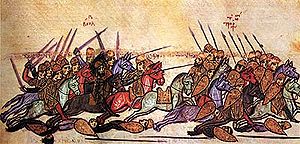
Kubrat’s successor, Khan Asparuh migrated with some Bulgarian tribes to the lower courses of the rivers Danube, Dniester and Dniepr (known as Ongal), and conquered Moesia and Scythia Minor (Dobrudzha) from the Byzantine Empire, expanding Great Bulgaria on the Balkan Peninsula. The peace treaty with Byzantium in 681 and the establishment of the new capital of Pliska south of the Danube is considered the beginning of the First Bulgarian Empire. At the same time one of his brothers, Kuber, settled with another Bulgar group in what is now Macedonia.
In 717, Bulgarians stopped the Arab siege of Constantinople, killing some 40,000-60,000 Arab soldiers, earning Bulgarian Khan Tervel a reputation as "The Saviour of Europe".
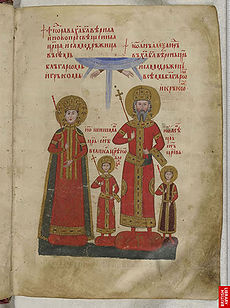
In 864, Bulgaria accepted the Orthodox Faith, and became a European power in the ninth and the tenth century, while fighting the Byzantine Empire for control of the Balkans. During the reign of Boris I, Bulgaria produced the Slavonic alphabet, which became a pillar for further cultural development. Centuries later, this alphabet along with the Old Bulgarian language became the intellectual written language (lingua franca) for Eastern Europe.
The greatest territorial extension was reached under Simeon I of Bulgaria the first Tsar, son of Boris I, covering most of the Balkans. During his reign, Bulgaria developed a rich, unique Christian Slavonic culture, which became an example for the other Slavonic peoples in Eastern Europe and ensured the continued existence of the Bulgarian nation.
Following a decline in the mid tenth century, worn out by the wars with Croatia and frequent Serbian rebellions sponsored by Byzantine gold, Bulgaria was crushed by an assault of the Rus' in 969. The Byzantines then began campaigns to conquer Bulgaria. In 971, they seized the capital Preslav and captured Emperor Boris II. Resistance continued under Tsar Samuil in the western Bulgarian lands for nearly half a century until the state was destroyed by the Byzantines led by Basil II in 1018.
Second Bulgarian Empire
In 1185, the Second Bulgarian Empire once again established Bulgaria as an important power in Europe for two more centuries. With its capital based in Veliko Turnovo and under the Asenevtsi Dynasty this empire fought for dominance in the region against the Byzantine Empire, the Crusader states and Hungary, reaching its zenith under Ivan Asen II (1218–1241).
By the end of the fourteenth century, the country had disintegrated into several feudal principalities and was eventually conquered by the Ottoman Empire. A Polish-Hungarian crusade under the rule of Władysław III of Poland to free the Balkans was crushed in 1444 in the battle of Varna.
Ottoman rule
Violence and oppression characterized the five centuries of Ottoman rule, decimating the Bulgarian population, and losing most of its cultural relics. Large towns and the areas where Ottoman power was strong were severely depopulated until the nineteenth century.
Kingdom of Bulgaria
Following the Russo-Turkish War, 1877-78, when Russian forces together with volunteered Bulgarian rebels was crushed the Ottoman Empire, and after the Treaty of San Stefano of March 3, 1878, an autonomous Bulgarian principality was proclaimed. The treaty was immediately rejected by Great Powers for fear that a large Slavic country on the Balkans would serve Russian interests. This led to the |Treaty of Berlin (1878) which provided for an autonomous Bulgarian principality comprising Moesia and the region of Sofia. The first Bulgarian prince was Alexander von Battenberg. Most of Thrace was included in the autonomous region of Eastern Rumelia, whereas the rest of Thrace and all of Macedonia was returned under the sovereignty of the Ottomans. After the Serbo-Bulgarian War and unification with Eastern Rumelia in 1885, the principality was proclaimed a fully independent kingdom in October 1908, during the reign of Ferdinand I of Bulgaria.
Ferdinand, a prince from the ducal family of Saxe-Coburg-Gotha, became the Bulgarian prince after Alexander von Battenberg abdicated in 1886 following a coup d'etat staged by pro-Russian army officers. The struggle for liberation of the Bulgarians in the Adrianople, Vilayet and Macedonia continued throughout the late nineteenth and early twentieth centuries culminating with the Ilinden-Preobrazhenie Uprising organised by the Internal Macedonian Revolutionary Organization (VMRO) in 1903.
Balkan Wars
In 1912 and 1913, Bulgaria became involved in the Balkan Wars, entering into conflict with Greece and Serbia against the Ottoman Empire. The campaign was a success for the Bulgarian army, but unfortunately the allies clashed over the division of Macedonia. Then a second Balkan war followed against its former Balkan allies in a desperate effort to achieve national unity. After being defeated in the Second Balkan War, Bulgaria lost most of the territory conquered in the first war, as well as Southern Dobruja.
World War I
During World War I, Bulgaria found itself fighting on the losing side after its alliance with the Central Powers. The defeat led to new territorial losses (the Western Outlands to Serbia, Western Thrace to Greece and the re-conquered Southern Dobruja to Romania. The Balkan Wars and World War I led to the influx of over 250,000 Bulgarian refugees from Macedonia, Eastern and Western Thrace and Southern Dobruja. These numbers increased in the 1930s following Serbian state-sponsored aggression against its native Bulgarian population.
In September 1918, Tsar Ferdinand abdicated in favour of his son Boris III in order to head off a revolution. Under the Treaty of Neuilly (November 1919), Bulgaria ceded the Aegean coastline to Greece, recognized the existence of Yugoslavia, ceded nearly all of its Macedonian territory to the new state, and had to give Dobruja back to the Romanians. The county was forced to reduce its army to 20,000 men, pay reparations exceeding $400-million. In Bulgaria, the results of the treaty are popularly known as the Second National Catastrophe
Elections in March 1920 gave the Agrarians a large majority, and Stamboliyski formed Bulgaria's first genuinely democratic government. He faced huge social problems, but was able to carry through many social reforms, although opposition from the Tsar, the landlords and the officers of the army was powerful. In March 1923, Stamboliyski signed an agreement with Yugoslavia recognising the new border and agreeing to suppress VMRO, which favoured a war to regain Macedonia for Bulgaria. This triggered a nationalist reaction, and on 9 June there was a coup after which Stamboliykski was beheaded. A right wing government under Aleksandar Tsankov took power, backed by the Tsar, the army and the VMRO, who waged a “white terror” campaign (acts of violence by monarchists) against the Agrarians and the Communists. In 1926, the Tsar persuaded Tsankov to resign and a more moderate government under Andrey Lyapchev took office and an amnesty was proclaimed, although the Communists remained banned. The Agrarians reorganised and won elections in 1931.
In May 1934 there was another coup, the Agrarians were again suppressed, and an authoritarian regime headed by Kimon Georgiev established with the backing of Tsar Boris. The Tsar's regime banned all opposition parties and took Bulgaria into alliance with Nazi Germany and Fascist Italy.
World War II
After regaining control over Southern Dobruja in 1940, Bulgaria allied with the Axis Powers in World War II, although no Bulgarian soldiers participated in the war against the USSR. During World War II, Nazi Germany allowed Bulgaria to occupy parts of Greece and Yugoslavia, including territories long coveted by the Bulgarians. Bulgaria was one of three countries (with Finland and Denmark) that saved its entire Jewish population (around 50,000) from the Nazi camps by refusing to comply with a August 31, 1943, resolution. But Jews in territories newly acquired from Greece and Yugoslavia were sent to death camps by the Bulgarian authorities on German request. In September 1944, the Soviet army entered Bulgaria, which later enabled the Bulgarian Communists to seize power and establish a Communist dictatorship. In 1944, Bulgaria's forces were turned against its former German ally (a 450,000 strong army in 1944, reduced to 130,000 in 1945). More than 30,000 Bulgarian soldiers and officers were killed in the war.
People's Republic of Bulgaria
From 1944-1989, the country was known as the "People's Republic of Bulgaria" (PRB) and was ruled by the Bulgarian Communist Party (BCP). The BCP transformed itself in 1990, changing its name to "Bulgarian Socialist Party", and remains part of the governing coalition government.
Although Dimitrov had been in exile, mostly in the Soviet Union, since 1923, he was far from being a Soviet puppet. He had shown great courage in Nazi Germany during the Reichstag Fire trial of 1933, and had later headed the Comintern during the period of the Popular Front. He was also close to the Yugoslav Communist leader Tito, and believed that Yugoslavia and Bulgaria, as closely related South Slav peoples, should form a federation. This idea was not favoured by Stalin, and there have long been suspicions that Dimitrov's sudden death in July 1949 was not accidental, although this has never been proven. It coincided with Stalin's expulsion of Tito from the Cominform, and was followed by a "Titoist" witchhunt in Bulgaria. This culminated in the show trial and execution of the Deputy Prime Minister, Traicho Kostov. The elderly Kolarov died in 1950, and power then passed to an extreme Stalinist, Vulko Chervenkov.
Bulgaria's Stalinist phase lasted less than five years. Agriculture was collectivised and peasant rebellions crushed. Labor camps were set up and at the height of the repression housed about 100,000 people. The Orthodox Patriarch was confined to a monastery and the Church placed under state control. In 1950 diplomatic relations with the U.S. were broken off. The Turkish minority was persecuted, and border disputes with Greece and Yugoslavia revived. The country lived in a state of fear and isolation. But Chervenkov's support base even in the Communist Party was too narrow for him to survive long once his patron, Stalin, was gone. Stalin died in March 1953, and in March 1954 Chervenkov was deposed as Party Secretary with the approval of the new leadership in Moscow and replaced by Todor Zhivkov. Chervenkov stayed on as Prime Minister until April 1956, when he was finally dismissed and replaced by Anton Yugov.
Republic of Bulgaria
In February 1990, the Communist Party voluntarily gave up its claim on power and in June 1990 the first free elections since 1931 were held, won by the moderate wing of the Communist Party, renamed the Bulgarian Socialist Party. In July 1991, a new constitution was adopted, in which there was a weak elected president and a prime minister accountable to the legislature.
The anti-Communist Union of Democratic Forces (UDF) took office and between 1992 and 1994 carried through the privatisation of land and industry, but this was accompanied by massive unemployment and economic difficulties. The reaction against economic reform allowed BSP to take office again in 1995, but by 1996 the BSP government was also in difficulties, and in the presidential elections of that year the UDF's Petar Stoyanov was elected. In 1997 the BSP government collapsed and the UDF came to power. Unemployment, however, remained high and the electorate became increasingly dissatisfied with both parties.
On June 17, 2001, Simeon Saxe-Coburg-Gotha, the son of Tsar Boris III and head of state as the Tsar of Bulgaria, from 1943 to 1946, won a narrow victory in the democratic elections held. The king's party - National Movement Simeon II ("NMSII") - won 120 out of 240 seats in Parliament and overturned the two pre-existing political parties. Simeon's popularity declined during his four-year rule as Prime Minister and BSP won the elections in 2005.
Since 1989, Bulgaria has held multiparty elections and privatized its economy, but economic difficulties and a tide of corruption led over 800,000 Bulgarians, most of them qualified professionals, to emigrate.
Government and politics
The politics of Bulgaria take place in a framework of a parliamentary representative democratic republic, whereby the Minister-Chairman is the head of government, and of a pluriform multi-party system.
The president of Bulgaria (Georgi Parvanov since January 2002) is directly elected for a five-year term with the right to one re-election. The president serves as the head of state and commander in chief of the armed forces. The president schedules elections and referenda, represents Bulgaria abroad, concludes international treaties, and heads the Consultative Council for National Security. The president may return legislation to the National Assembly for further debate—a kind of veto—but the legislation can be passed again by an absolute majority vote.
The Council of Ministers (cabinet) is usually formed by the majority party in Parliament, if one exists, or by the largest party in Parliament along with coalition partners. Chaired by the prime minister, it is responsible for carrying out state policy, managing the state budget, and maintaining law and order.
The Bulgarian unicameral parliament, the National Assembly or Narodno Sabranie, consists of 240 deputies who are elected for four-year-terms by popular vote. The votes are for party or coalition lists of candidates for each of the 28 administrative divisions. A party or coalition must garner a minimum of 4 percent of the vote in order to enter parliament. Parliament enacts laws, approves the budget, schedules presidential elections, selects and dismisses the prime minister and other ministers, declares war, deploys of troops outside of Bulgaria, and ratifies international treaties and agreements. Suffrage is universal to those aged 18 years and over.
The last elections took place on June 2005. The next elections are planned for summer 2009. The governmental coalition in 2007 was made up of the Bulgarian Socialist Party (BSP), National Movement Simeon II (NMS) and the Movement for Rights and Freedoms (representing mainly the Turkish minority).
The Bulgarian judicial system consists of regional, district and appeal courts, as well as a Supreme Court of Cassation. In addition, there is a Supreme Administrative Court and a system of military courts. The presidents of the Supreme Court of Cassation, Supreme Administrative Court and the Prosecutor General are elected by a qualified majority of two-thirds from all the members of the Supreme Judicial Council and are appointed by the president. The Supreme Judicial Council is in charge of the self-administration and organization of the Judiciary.
The Constitutional Court is in charge of reviewing the constitutionality of laws and statutes brought before it, as well as the compliance of these laws with international treaties that the Government has signed. Parliament elects the twelve members of the Constitutional Court by a two-thirds majority, the members serve a nine-year term.
After the fall of communist regime, crime escalated — mostly property and car theft. Allegations of corruption are widespread, and organised crime is believed to control some economic sectors.
Between 1987 and 1999, Bulgaria consisted of nine provinces (oblasti, singular oblast); since 1999, it has consisted of 28, each headed by a provincial governor appointed by the government. All are named after their capital city. The provinces are subdivided into 287 municipalities.
Bulgaria joined NATO on March 29, 2004 and signed the Treaty of Accession on 25 April 2005. It became a full member of the European Union on 1 January 2007. The country has been a member of the United Nations since 1955, and is a founding member of Organization for Security and Co-operation in Europe. As a Consultative Party to the Antarctic Treaty, Bulgaria takes part in the governing of the territories situated south of 60° south latitude.
Military
The Military of Bulgaria comprises the Bulgarian land forces, Bulgarian Navy and Bulgarian Air Force. Following a series of reductions beginning in 1989, the active troops of Bulgaria's army number as many as 68,450. Reserve forces include 303,000 soldiers and officers. "PLAN 2004," an effort to modernize Bulgaria's armed forces, aims to better meet the military needs of NATO and the European Union.
Bulgarian military personnel have been involved in international missions in Cambodia, Bosnia and Herzegovina, Kosovo, Afghanistan and Iraq. Compulsory military service was to be abolished in 2008.
In April of 2006, Bulgaria and the United States signed a defense cooperation agreement providing for the development of the Bulgarian air bases at Bezmer (near Yambol) and Graf Ignatievo (near Plovdiv), the Novo Selo training range (near Sliven), and a logistics centre in Aytos as joint US-Bulgarian military facilities.
Bulgaria's navy is comprised mainly of Soviet-era ships, and two submarines. With only 354 km of coastline, assault by sea is not considered a major risk for Bulgaria. In the course of recent modernization efforts, one new frigate was purchased from Belgium, and the navy is finalizing a deal with French company DCN for the acquisition of four Gowind corvettes.
Bulgaria's air forces also use a large amount of Soviet equipment. Plans to acquire transport and attack helicopters are underway, in addition to a major overhaul on old Soviet weapons and GPS systems
Economy
The economy of Bulgaria declined dramatically during the 1990s with the collapse of the COMECON system, which was an economic organization of communist states, and the loss of the Soviet market, to which the Bulgarian economy had been closely tied. The standard of living fell by about 40 percent, and only regained pre-1989 levels by June of 2004. In addition, United Nations economic sanctions against Serbia (1992-95) and Iraq took a heavy toll on the Bulgarian economy.
The first signs of recovery emerged when gross domestic product grew 1.4 percent in 1994 for the first time since 1988, and 2.5 percent in 1995. Inflation, which surged in 1994 to 122 percent, fell to 32.9 percent in 1995.
During 1996, however, the economy collapsed due to the Bulgarian Socialist Party, slow and mismanaged economic reforms, its disastrous agricultural policy, and an unstable and decentralized banking system, which led to an inflation rate of 311 percent and the collapse of the lev, the Bulgarian currency. When pro-reform forces came into power in the spring 1997, an ambitious economic reform package, including introduction of a currency board regime, was agreed to with the International Monetary Fund and the World Bank, and the economy began to stabilize. As of 2007 the economy is growing at a steady pace of above 5 percent a year with budget deficits and shaky inflation. Future prospects are tied to the country's increasingly important integration with the European Union member states. The country is expected to join the Eurozone between 2010 and 2012.
Agriculture and industry
Agricultural output has decreased since 1989, but production is growing in recent years. The prevalence of mechanisation is higher than most other Eastern European countries but there is lack of modern equipment. Alongside aeroplanes and other equipment, there are over 150,000 tractors and 10,000 combine harvesters. The most important crops include wheat, sunflower, maize, grapes, tobacco, tomatoes, barley, potatoes and roses for rose oil.
Although Bulgaria is not rich in reserves of coal, oil, and gas, it is a major producer of electricity and the most important exporter in the region due to the Kozloduy Nuclear Power Plant with a total capacity of 3,760 MW. A second plant, the Belene Nuclear Power Plant with a capacity of 2,000 MW is under construction. There is a $1,400,000,000 project for construction of an additional 670 MW for the 500 MW Maritza Iztok 1 Thermal Power Plant.
The production of steel and pig iron is concentrated in Kremikovtsi and Pernik. There is also a third metallurgical base in Debelt. The largest refineries for lead and zinc are in Plovdiv, Kardzhali and Novi Iskar; for copper in Pirdop and Eliseina; and for aluminium in Shumen. About 14 percent of the total industrial production is related to machine building and 24 percent of the people are employed in this field.
Electronics and electric equipment production is well developed. The largest centres are Sofia, Plovdiv and surrounding areas. These plants produce household appliances, computers, CDs, telephones, medical and scientific equipment.
There are plants producing trains, trams, trolleys, buses, trucks, and motor cars. The main centre of agricultural machinery is Ruse. Shipbuilding is concentrated in Varna, Burgas and Ruse. Arms production is mainly developed in central Bulgaria.
Science and technology
Bulgaria offers excellent conditions for high-tech and telecommunication industries and services with its strategic location, highly-qualified workforce, macroeconomic stability, growing domestic market and good education. This is why some multinational companies choose Bulgaria to build their regional offices and headquarters even before Bulgaria joined the EU. The most notable is Hewlett-Packard, which built its Global Service Centre for Europe, the Middle East and Africa in Sofia.
The country has some precedents for its current science industry. The inventor of the earliest known electronic computer John Atanasoff is of Bulgarian descent. Bulgaria was a major supplier of scientific and research instruments for the Soviet space programmes, was the first European country to develop serial computer production, and has experience in pharmaceutical research and development. The Bulgarian Academy of Sciences is the leading scientific institution in the country with most of the researchers working for its numerous branches.
There are two major astronomical observatories: the Rozhen Observatory, which is the biggest in South Eastern Europe, and the Belogradchik Observatory, with three telescopes.
Tourism
In winter, Samokov, Borovets, Bansko and Pamporovo are popular ski resorts. There are summer resorts on the Black Sea at Sozopol, Nessebur, Golden Sands, Sunny Beach, Sveti Vlas, Albena, St. Constantine & Helena and many others. Spa resorts such as Bankya, Hisarya, Sandanski, Velingrad, Varshets and many others are popular all over the year. Bulgaria is becoming an attractive destination because of the quality of the resorts and prices below those found in Western Europe.
Bulgaria has enjoyed a substantial growth in income from international tourism over the past decade. Beach resorts are popular with tourists from Germany, Russia, Scandinavia and the United Kingdom. The ski resorts are a favourite destination for British and Irish tourists.
Property ownership
Most agricultural land was restored to their former (pre-collectivization) owners or their heirs following communism's collapse, and legislation in 1997 restored to their former owners forests that were privately owned before forest nationalization in 1947. Most pre-collectivization landholdings were small. Ownership of agricultural land and forests is restricted to Bulgarian citizens, government entities, and organizations. Foreigners, however, are permitted use rights. Foreigners seeking additional homes have boosted the property market. Buyers from across Europe, mostly from the United Kingdom, were attracted by relatively cheap property.
Exports totalled $15.5-billion in 2006. Export commodities included clothing, footwear, iron and steel, machinery and equipment, and fuels Export partners included Italy 12 percent, Turkey 10.5 percent, Germany 9.8 percent, Greece 9.5 percent, Belgium 5.9 percent, and France 4.6 percent. Imports totalled $23.8-billion. Import commodities included machinery and equipment; metals and ores; chemicals and plastics; fuels, minerals, and raw materials. Import partners included Russia 15.6 percent, Germany 13.6 percent, Italy 9 percent, Turkey 6.1 percent, Greece 5 percent, and France 4.7 percent.
Per capita GDP was $10,843 in 2007, or 65th on a list of 194 countries. The unemployment rate in 2006 was 9.6 percent. About 14.1 percent of the population was below the poverty line in 2003.
Demographics
According to the 2001 census,[2] Bulgaria's population is mainly ethnic Bulgarian (83.9%), with two sizable minorities, Turks (9.4%) and Roma (4.7%). Of the remaining 2.0%, 0.9% are distributed among some 40 smaller minorities, the most numerous of which are the Russians, Armenians, Vlachs, Jews, Crimean Tatars and Karakachans. 1.1% did not declare their ethnicity.
Bulgarian is the mother language of 84.8% of the population; it is a member of the Slavic languages. Bulgarian is the only official language, but other languages such as Turkish and Romany, are spoken corresponding closely to ethnic breakdown.
Most Bulgarians (82.6%) are, at least nominally, members of the Bulgarian Orthodox Church, the national Eastern Orthodox church. Other religious denominations include Islam (12.2%), various Protestant denominations (0.8%), Roman Catholicism (0.5%), with other denominations, atheists and undeclared numbering ca. 4.1%.
In the recent years Bulgaria has had one of the slowest population growth rates in the world. Growth has been negative since the early 1990s[3], due to the economic collapse and high emigration. In 1988 the population was 8,859,000 people, and in 2001 7,950,000. Now Bulgaria suffers a heavy demographic crisis.
Culture
A country often described to lie at the crossroads linking the East and West, Bulgaria was the centre of Slavic Europe during much of the Middle Ages, exerting considerable literary and cultural influence over the Eastern Orthodox Slavic world by means of the Preslav and Ohrid Literary Schools. Bulgaria is also the birthplace of the Cyrillic alphabet, the second most widely used alphabet in the world, which was developed in these two schools in the tenth century.
Bulgaria is well-known for its rich folklore, distinctive traditional music, rituals and tales, but the country's contribution to humanity also continued in the nineteenth and twentieth century, when individuals such as John Atanasoff - born in USA with Bulgarian origin, regarded as the father of the digital computer, a number of noted opera singers (Nicolai Ghiaurov, Boris Christoff, Raina Kabaivanska, Ghena Dimitrova) and successful artists (Christo Javacheff, Pascin, Vladimir Dimitrov) popularized the culture of Bulgaria abroad.
A number of ancient civilizations, most notably the Thracians, Greeks, Romans, Slavs and Bulgars, have left their mark on the culture, history and heritage of Bulgaria. The country has nine UNESCO World Heritage Sites. Of these, two are Thracian tombs (one in Sveshtari and one in Kazanlak), three are monuments of medieval Bulgarian culture (the Boyana Church, the Rila Monastery and the Rock-hewn Churches of Ivanovo), while the Pirin National Park and the Srebarna Nature Reserve represent the country's natural beauty, and the ancient city of Nesebar is a unique combination of European cultural interaction, as well as, historically, one of the most important centres of naval trade in the Black Sea. In addition, the Varna Necropolis, a 3500-3200 BC burial site, contains what are believed to be the oldest examples of worked gold in the world.
Sports
Football is by far the most popular sport in the country. Many Bulgarian fans follow closely the top Bulgarian league, the Bulgarian "A" Professional Football Group, as well as the leagues of other European countries, such as those of Spain, England, Italy and Germany. The greatest success of the Bulgaria national football team was a fourth place finish at the 1994 FIFA World Cup in the United States. Certainly, the best known Bulgarian footballer is Hristo Stoichkov. He is widely regarded as one of the world's finest football players at the peak of his career between 1992 and 1995, while playing for FC Barcelona winning the Ballon d'Or in 1994. Additionally, he was named in the FIFA 100 ranking. Georgi Asparuhov-Gundi (1943-1971), was himself extremely popular at home and abroad having had offers from clubs in Italy and Portugal. He died tragically in a car accident at the peak of his career. He was awarded Bulgarian football player №1 for the twentieth century. PFC CSKA Sofia (champion of Bulgaria 30 times) and PFC Levski Sofia (25 times champion of Bulgaria and 26 times holder of the National Cup as of 2007) are the most successful Bulgarian football clubs. Other popular clubs include PFC Lokomotiv Sofia, PFC Litex Lovech, PFC Lokomotiv Plovdiv and PFC Botev Plovdiv. PFC Levski Sofia is the first Bulgarian team to have participated in the modern UEFA Champions League (after 1989) having achieved this by qualifying for the 2006/2007 competition.
Aside from football, Bulgaria boasts great achievements in a great variety of other sports. Maria Gigova and Maria Petrova each have a record of three world titles in rhythmic gymnastics. Some other famous gymnasts include Simona Peycheva, Neshka Robeva (a highly successful coach as well) and Yordan Yovtchev. Bulgarians are also dominant in weightlifting, with around 1,000 gold medals in different competitions, and wrestling; Stefan Botev, Nickolai Peshalov, Demir Demirev and Yoto Yotov are among the most distinguished weightlifters and Serafim Barzakov, Armen Nazarian and Sergey Moreyko are world-class wrestlers.
Bulgarians also take great pride in the country's achievements in athletics. Stefka Kostadinova, who still holds the women's high jump world record, jumped 209 centimetres at the 1987 World Championships in Athletics in Rome to clinch the coveted title. Presently, Bulgaria is proud of its sprinters, namely Ivet Lalova and Tezdzhan Naimova.
Volleyball recently marked a big resurgence. The Bulgarian national volleyball team is one of the strongest teams in Europe, currently ranked fifth in the FIVB ranklist. At the 2006 Volleyball World Championship, they won the bronze medal. Chess is also very popular. One of the top chess-masters in the world, Veselin Topalov, is Bulgarian. At the end of 2005, both men's and women's world chess champions were Bulgarian as well as the junior world champion.
At the 1998 Winter Olympics, Ekaterina Dafovska won the Olympic title from 15 km competition in biathlon and Irina Nikulchina took a bronze medal at the same Olympic Games. Another pride for the Bulgarian nation in winter sports is Evgenia Radanova, who won bronze and silver medals in the following two Olympic Games. Albena Denkova and Maxim Staviski are another example of Bulgarian champions on the ice — this time speaking of ice dancing and figure skating. The couple is the reigning world champions, holding the title for both 2006 and 2007. The couple also won the ISU Grand Prix Final in St. Petersburg in December 2006.
Bulgaria's state agency for Youth and Sport is the governing body for sport in Bulgaria. The current minister in charge of it is Vesela Lecheva. As of November 11 2005, Stefka Kostadinova is the President of the Bulgarian Olympic Committee.
Religion
Most citizens of Bulgaria are associated — at least nominally — to the Bulgarian Orthodox Church. It was founded in 870 AD under the Patriarchate of Constantinople from which it obtained its first primate, its clergy and theological texts. It has been autocephalous since 927. The Bulgarian Patriarchate was established in Sofia after the creation of the Bulgarian Exarchate, in 1870. The Bulgarian Orthodox Church is the independent national church of Bulgaria like the other national branches of Eastern Orthodoxy and is considered an inseparable element of Bulgarian national consciousness. The church became subordinate within the Patriarchate of Constantinople, twice during the periods of Byzantine (1018 – 1185) and Ottoman (1396 – 1878) domination but has been revived every time as a symbol of Bulgarian statehood without breaking away from the Orthodox dogma. In 2001, the Bulgarian Orthodox Church had 6,552,000 members in Bulgaria (82.6% of the population). However, many people raised during the 45 years of communist rule are not religious, even though they may formally be members of the church.
Despite the dominant position of the Bulgarian Orthodox Church in Bulgarian cultural life, a number of Bulgarian citizens belong to other religious denominations, most notably Islam, Roman Catholicism and Protestantism. Islam came to Bulgaria at the end of the fourteenth century after the conquest of the country by the Ottomans. It gradually gained ground throughout the fifteenth and sixteenth centuries by the introduction of Turkish colonists and the conversion of native Bulgarians. At the time of Liberation (1878) no less than 40% of the population was Muslim, but by the end of the Liberation, ethnic clensing had led to a major decrease in Muslim populations[4]. In 2001, there were 967,000 Muslims in Bulgaria, accounting for 12.2% of the total population.
In the sixteenth and the seventeenth century, missionaries from Rome converted Bulgarian Paulicians in the districts of Plovdiv and Svishtov to Roman Catholicism. Today, their descendants form the bulk of Bulgarian Catholics whose number stands at 44,000 in 2001. Protestantism was introduced in Bulgaria by missionaries from the United States in 1857. Missionary work continued throughout the second half of the nineteenth and the first half of the twentieth century. In 2001, there were some 42,000 Protestants in Bulgaria.
According to the most recent Eurostat "Eurobarometer" poll, in 2005,[5] only 40% of Bulgarian citizens responded that "they believe there is a God", whereas 40% answered that "they believe there is some sort of spirit or life force", 13% that "they do not believe there is a God, spirit, nor life force", and 6% did not answer.
National and natural parks
Bulgaria has 3 national parks, 10 natural parks, 90 reserves, 429 reservation areas and 350 natural landmarks. The best known and most popular of these are listed below. In the European Union, Bulgaria is at second place (after Spain) by the number of the UNESCO Biosphere reserves, 16. The first nature reserve in the country was Silkosia in the Strandzha mountain, declared in 1931; followed by Parangalitsa, Rila in 1933.
- Parks in Bulgaria
- Rila National Park
- Pirin National Park
- Central Balkan National Park
- Rhodope Mountains
- Stara Planina (Balkan Mountains)
- Strandzha Natural Park
- Vitosha Natural Park
- Vratza Balkan Natural Park
Facts
- Founded in 681, Bulgaria is Europe's oldest state with internationally recognized independence (635 C.E.). [citation needed]
- The country produces half of the rose oil in the world.
- In many agricultural productions per capita, the country is among the top 10 in the world (tomatoes, peppers, tobacco, sunflower seed, lavender, strawberries and others)
- The first air-dropped bomb in military history was developed by the Bulgarian Air Force during the First Balkan War [6] and used on 16 October 1912 by Lieuts. Radul Milkov and Prodan Tarakchiev. Rayna Kasabova was the first woman ever to take part in a combat air mission, accomplished on 30 October 1912.
- A developer of the combined oral contraceptive pill, Carl Djerassi is of Bulgarian descent.
- Bulgarian Beach on Livingston Island in the South Shetland Islands, Antarctica is named for Bulgaria.
- World's first digital wristwatch was developed by the Bulgarian Peter Petroff.
- Bulgaria is the birthplace of the Cyrillic alphabet, the second most widely used alphabet in the world.
- In the modern history Bulgaria never lost a flag, captured by an enemy army.
- Xenophon wrote that "it was known that a group of Bulgars invented the wheel in the greats Steppe".
See also
Template:Bulgaria-related topics
Notes
- ↑ 1.0 1.1 This article uses the official Bulgarian transliteration system to romanize Bulgarian Cyrillic. For details, see Romanization of Bulgarian.
- ↑ National Statistical Institute of Bulgaria, retrieved July 31, 2006
- ↑ [1]
- ↑ McCarthy, J. (1996). Death and Exile: The Ethnic Cleansing of Ottoman Muslims, 1821-1922. Princeton, N.J: Darwin Press, 88–91. ISBN 0878500944.
- ↑ Social values, science and technology (pdf). Eurobarometer. European Commission (June 2005). Retrieved 2007-01-01.
- ↑ https://www.airforcehistory.hq.af.mil/PopTopics/histechintel.htm
Further reading
- Raymond Detrez. Historical Dictionary of Bulgaria Second Edition. 2006. lxiv + 638 pp. Maps, bibliography, appendix, chronology. ISBN 978-0-8108-4901-3.
- RJ Crampton. A Concise History of Bulgaria
- Lampe, John R., and Marvin R. Jackson. Balkan Economic History, 1550-1950: From Imperial Borderlands to Developing Nations. 1982. online edition
- Lampe, John R. The Bulgarian Economy in the Twentieth Century. 1986.
Pre 1939
- Hall, Richard C. Bulgaria's Road to the First World War. Columbia University Press, 1996.
- Mercia MacDermott; A History of Bulgaria, 1393-1885 (1962) online edition
- Duncan M. Perry; Stefan Stambolov and the Emergence of Modern Bulgaria, 1870-1895 (1993) online edition
- Steven Runciman; A History of the First Bulgarian Empire (1930) online edition
World War II
- Michael Bar-Zohar. Beyond Hitler's Grasp: The Heroic Rescue of Bulgaria's Jews
- Stephane Groueff. Crown of Thorns : The Reign of King Boris III of Bulgaria, 1918–1943
- Tzvetan Todorov The Fragility of Goodness: Why Bulgaria's Jews Survived the Holocaust
Communist era
- Tzvetan Todorov. Voices from the Gulag: Life and Death in Communist Bulgaria
- The Iron Fist - Inside the Bulgarian secret archives Alexenia Dimitrova
Contemporary
- John D. Bell, ed. Bulgaria in Transition: Politics, Economics, Society, and Culture after Communism (1998) online edition
Guide books
- Blue Guide: Bulgaria James Pettifer
- Paul Greenway, Lonely Planet World Guide: Bulgaria
- Timothy Rice, Music of Bulgaria
- Jonathan Bousfield. The Rough Guide To Bulgaria
External links
Official
- Council of Ministers
- Diplomatic missions Portal of Bulgaria abroad
- European Youth Parliament - Bulgaria
- The Presidential official site
- Narodno Sabranie - The National Assembly
- Ministry of Education
- Ministry of Agriculture & Forestry
- Ministry of Culture
- Ministry of Defense
- Ministry of State Policy for Disasters and Accidents
- Ministry of Economy and Energy
- Ministry of Environment and Water
- Ministry of European Affairs
- Ministry of Finance
- Ministry of Foreign Affairs
- Ministry of Health
- Ministry of Interior
- Ministry of Justice
- Ministry of Labor & Social Policy
- Ministry of Regional Development and Public Works
- Ministry of Public Administration
- Ministry of Transport
- Ministry of Energy and Energy Resources - apparently cancelled. more official information at this link
- State Agency for Tourism
- State Agency for Youth and Sport
- State Agency for Information Technology and Communications
- National Radio
- Antarctic Place-names Commission of Bulgaria
English-language Bulgarian media
- Bulgarian News Agency
- Radio Bulgaria – the world service of the Bulgarian National Radio
- Dnevnik News
- The Bulgarian Post
- Focus English News
- Sofia News Agency
- Template:Bg icon (English) Southeast European Times
- Standart (daily)
- The Sofia Echo (weekly)
- The Frontier Times — Bulgaria's English Language Newspaper (monthly)
- Bulgaria Info Online Magazine — Free online monthly magazine all about BG
Other
- Bulgaria joins the EU – France 24 special Report
- Bulgaria at Wikitravel - Travel Guide and tourist information on Bulgaria
- Bulgarian musical instruments
- Collection of Bulgarian Art
- Bulgarian Folklore (Eurofolk)
- The Surva International Festival of the Masquerade Games in city of Pernik
- CIA World Factbook entry on Bulgaria
- Bulgaria in pictures
- Free images from bulgaria with high resolution under CC 2.5
- The Bulgarian Photo Album
- Monasterys, castles, ruins
- Will EU Entry Shrink Bulgaria's Population Even More?
- Pictures from Bulgaria
- Treasures of the national library of Bulgaria displayed via The European Library
Credits
New World Encyclopedia writers and editors rewrote and completed the Wikipedia article in accordance with New World Encyclopedia standards. This article abides by terms of the Creative Commons CC-by-sa 3.0 License (CC-by-sa), which may be used and disseminated with proper attribution. Credit is due under the terms of this license that can reference both the New World Encyclopedia contributors and the selfless volunteer contributors of the Wikimedia Foundation. To cite this article click here for a list of acceptable citing formats.The history of earlier contributions by wikipedians is accessible to researchers here:
The history of this article since it was imported to New World Encyclopedia:
Note: Some restrictions may apply to use of individual images which are separately licensed.

